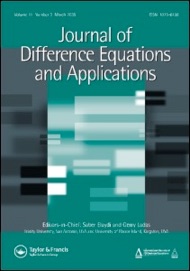Special Issue JDEA
AAU
Together with Peter Kloeden we coedited a special issue of the Journal of Difference Equations and Applications devoted to
Nonautonomous Difference Equations and Discrete Dynamical Systems
(Volume 17, No. 2, 2011). It centers around the following aspects:
The theory of dynamical systems has seen spectacular developments in the past 100 years, beginning with the contributions of Poincaré and Lyapunov to a contemporary complete understanding of the attractor for various infinite-dimensional systems. This, in part, is due to the restriction to autonomous systems. However, many real world problems are in fact nonautonomous. That is, they involve time-dependent parameters, controls, modulation and various other effects. Special cases include periodically or almost periodically forced systems, but in principle the time dependence can be arbitrary. As a consequence, many of the now well-established concepts, methods and results for autonomous systems are not longer applicable and require appropriate extensions.
The recent decade has seen conceptual progress for nonautonomous systems, in particular ambient definitions of invariance, convergence, hyperbolicity and attractors. In the discrete time case such nonautonomous systems are generated by difference equations, that is, for which the right hand side depends explicitly on the current time. The corresponding applications are wide-spread, ranging from modeling to discretizations.
This special issue, dedicated to nonautonomous discrete dynamical systems illustrates these advances in seven papers and their usefulness with a broad selection of topics:
-
•F. Balibria and R. Chacón study the simple linear equation $x_{n+1}=a_nx_n$, where the real sequence $a_n$ is a nonautonomous perturbation of a constant $a>1$, and observe complex dynamical behavior.
-
•The contribution by A. Berger continues his work on Benford's law of logarithmic mantissa distributions. Sufficient as well as necessary conditions for difference equations $x_n=T_n(x_{n-1})$ are given, such that the solution sequence $(x_n)_{n\geq 0}$ confirms Benford's law in its strongest form.
-
•An infinite-dimensional system continuous in time, but spatially discrete, is considered by T. Caraballo, F. Morillas and J. Valero under the influence of additive noise. The theory of multi-valued dynamical system implies the existence of a compact random attractor.
-
•The paper by V. Kozyakin discusses an iteration scheme to compute the joint spectral radius of (irreducible) spectral sets based on Barabanov norms.
-
•Delay difference equations are studied by E. Liz. Using discrete inequalities and monotonicity techniques various (global) stability and attractivity results are obtained.
-
•K.J. Palmer tackles the problem of hyperbolicity for linear difference equations in form of an exponential dichotomies. He proves that a dichotomy on sufficiently many large intervals guarantees a dichotomy on the whole axis, and gives various applications.
-
•Differential equations with piecewise constant argument typically require methods initially developed in discrete time. The article by M. Pinto presents various basic results for such equations with applications to stability problems.

Christian Pötzsche (Mar 2011)